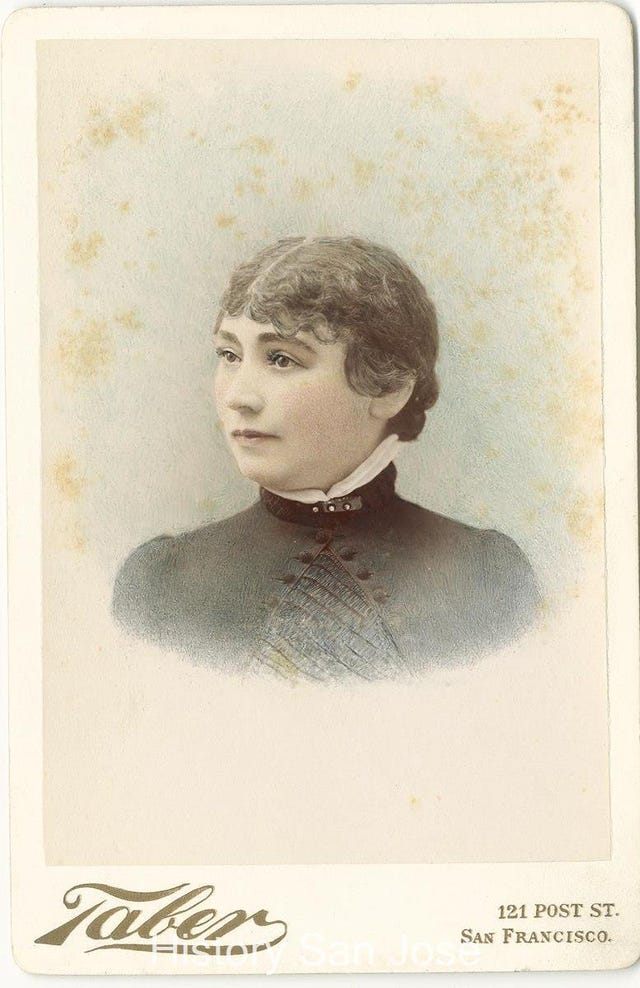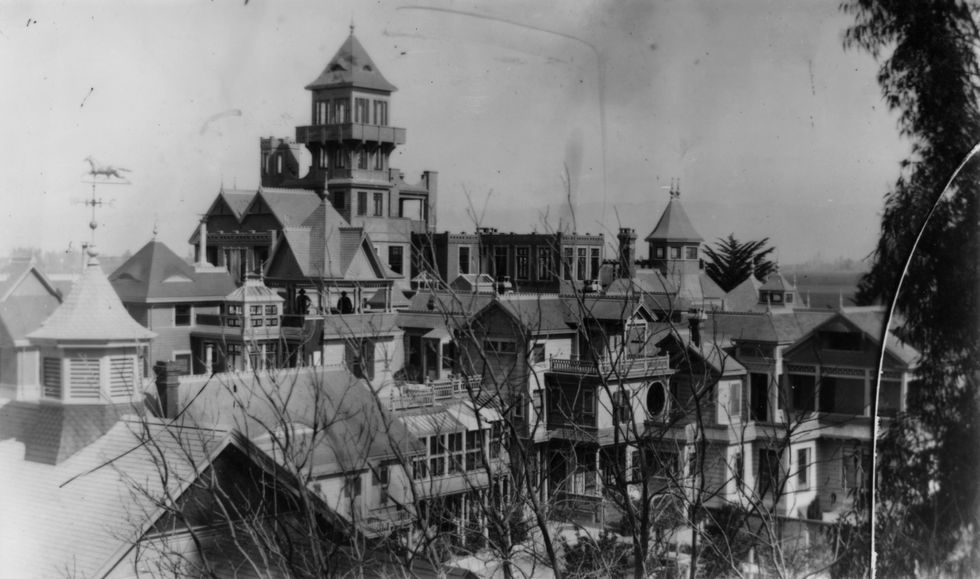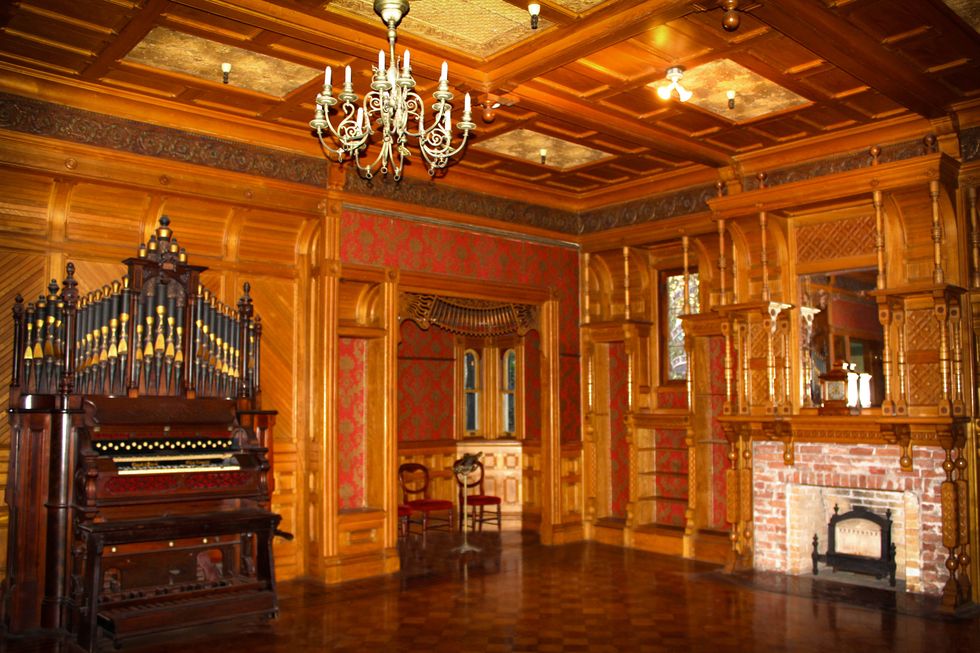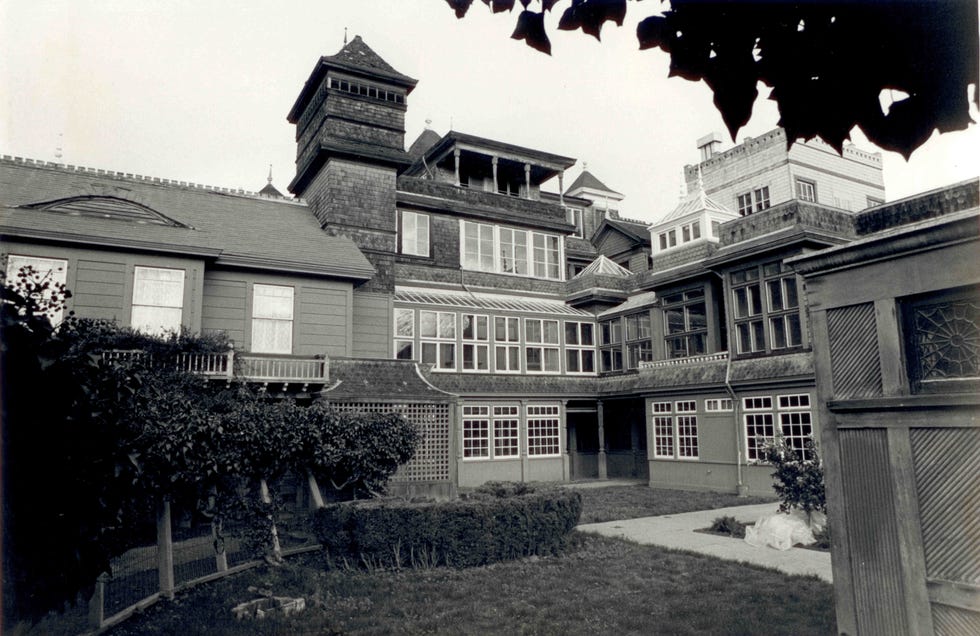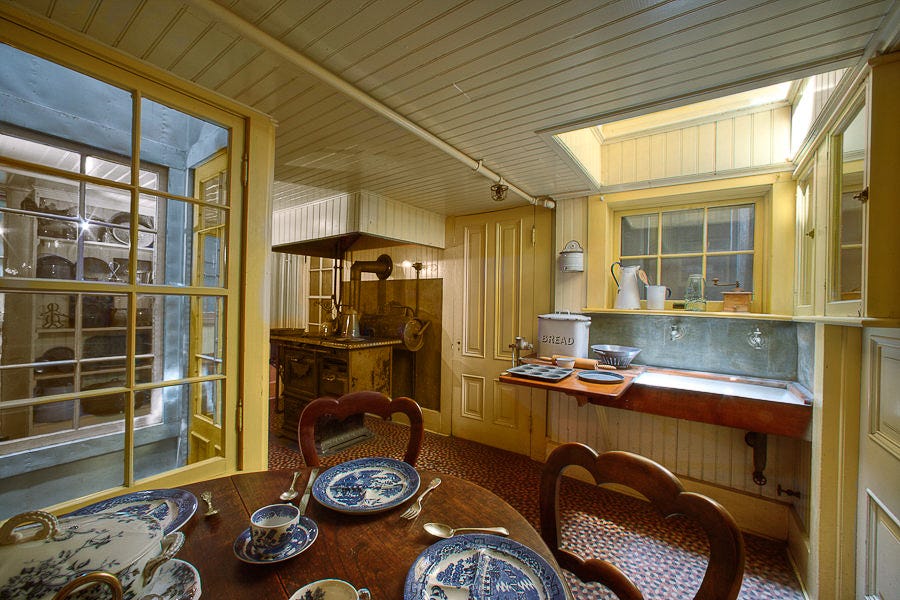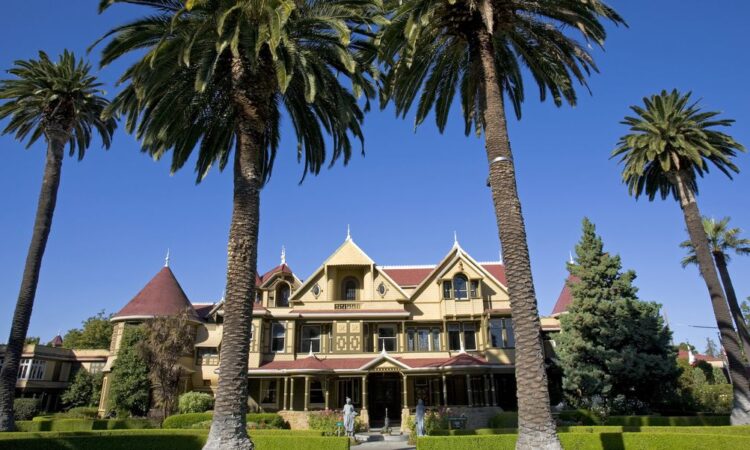
The full story of the Winchester Mystery House is featured in season 3, episode 1 of House Beautiful’s haunted house podcast, Dark House. You can listen to the full episode on Spotify.
What started out in the mid-1800s as a modest eight-room farmhouse in California’s Santa Clara Valley has become one of the most recognizable and notoriously mysterious mansions and haunted house attractions in America: the Winchester Mystery House, as it’s known today. The sprawling—and incongruous—Queen Ann Revival home was rifle heiress Sarah Pardee Winchester’s constantly-in-progress (and forever unfinished) hobby home that she dubbed Llanada Villa in honor of the region’s Spanish roots and her love of the Basque countryside.
As the widow of William Winchester, whose family’s eponymous company, The Winchester Repeating Arms Company, Sarah came into a $20 million inheritance along with 50 percent ownership in the firearms business when William died in 1881. That fortune enabled her to transform the humble ranch house into a massive mansion on hundreds of acres, but it also fueled rumors that Sarah built the home to escape the spirits of those killed by the Winchester rifle. Read on to learn more about the design of the Winchester Mystery House, as well as the true motivations behind it.
The Real Origins of the Winchester Mystery House
Following the deaths of multiple family members—including her infant daughter in 1865, her father in 1869, her mother in 1880, both her father-in-law and husband in 1881, and her sister in 1884—Sarah left her hometown of New Haven, Connecticut, to make a fresh start just outside San Jose, California. Within just a few months, she’d already added more than a dozen rooms onto her new home with the intention of accommodating her two little sisters and their families. For the next 38 years, reports claim, the property would be constantly under construction, 24 hours a day, 7 days a week. Sarah designed all of the additions on her own despite having no formal training. Construction ended only upon her death in the mansion in September 1922, leaving it incomplete and her plans unfinished.
The Winchester Mystery House Today
What stands today is four-story, 160-room, 24,000-square-foot mansion constructed mostly out of redwood on less than five remaining acres of land in one of the city’s most heavily trafficked West Valley neighborhoods. The home has 2,000 doors (some leading straight into blank walls), 10,000 windows (some interior facing), 47 fireplaces, 17 chimneys, 40 stairways (at least one of which leads up to a ceiling), 40 bedrooms, two ballrooms (one completed, one unfinished), 13 bathrooms, six kitchens, three elevators, two basements, and a wood-paneled, Venetian-inspired dining room—whew.
There are gold and silver chandeliers, hand-inlaid parquet floors, and many original stained-glass windows rumored to have been created by Tiffany. At one point prior to the 1906 earthquake, the house stood seven stories tall, but it was reduced—likely due to damage caused by the quake. In fact, after the quake, Sarah all but stopped work on the front wing of the house. Luckily, the home was spared total destruction during both the 1906 and 1989 Loma Prieta earthquakes because it was built using a floating foundation— a design that allows the structure to move freely as its only semiattached to its base.
Few people aside from household staff and teams of carpenters and other workmen were invited into the mansion during Sarah’s lifetime, and very few if any interior photographs were taken. The furniture inside the home today reflects the period, but her personal belongings, including the contents of the house, were left to her niece, Marian Marriott, who kept what she wanted and sold the remainder at auction.
Is the Winchester Mystery House Haunted?
It’s a question people have asked ever since Sarah started construction. In order to make sense of this perceived monstrosity in what was then a rural community, rumors began to swirl about her motivations. According to folklore, Sarah was motivated to build a home with such odd features because a medium told her that the ghosts of those killed by the Winchester rifle would haunt her until the day she died unless she went out west to build a house with room for all of them. Other versions of the story purport that Sarah was driven west because she was being haunted in the family mansion in New Haven. Unfortunately for her, the ghosts followed her to California, so she tried to outsmart them by building a rambling home with a tangle of hallways.
Historians have never been able to corroborate the visit with the medium, and many of Sarah’s longtime employees and friends denied the story both during and after her lifetime. And, of course, the truth is likely bit simpler: Sarah’s father had been a carpenter during the height of the Victorian period, and so she grew up loving design and architecture. She later subscribed to many magazines and journals on the subjects and taught herself the craft.
The rumors only grew after her death, when the property sold at auction to a private investor for around $135,000—today just north of $2 million. It was then leased to John and Mayme Brown for a 10-year period. The couple opened the house up to the public in 1923 and eventually bought the property (which is now owned by a privately held company that represents their descendants). The home was designated a historic landmark in 1974, and it’s listed in the National Registry of Historic Places.
Ongoing Renovations
In September 2019, one of the many mysteries of the Winchester House, as the National Registry of Historic Places refers to it, was solved during restoration work in one of its many dining rooms. According to the Times Union, workers were removing parts of the wall when they noticed something peculiar: a beautifully preserved envelope tucked inside from 100 years ago from the Pacific American Decorative Company.
This discovery confirmed something that many historians had a hunch about: the true artisan who made its impeccable stained glass windows. Recently, architectural historian Jim Wolf dug into the mystery of who actually created them, and he landed on the answer that it was actually glassworker John Mallon. Well, turns out Mallon owned Pacific American Decorative Company. Case. Closed.
Hauntings and spirit sightings aside, a tour of the fabled home is definitely worth the price of admission.
Want to hear more ghost stories about the Winchester Mystery House? Listen to this week’s episode of our haunted house podcast series, Dark House, for exclusive ghost stories and insights into the home’s haunted reputation.

